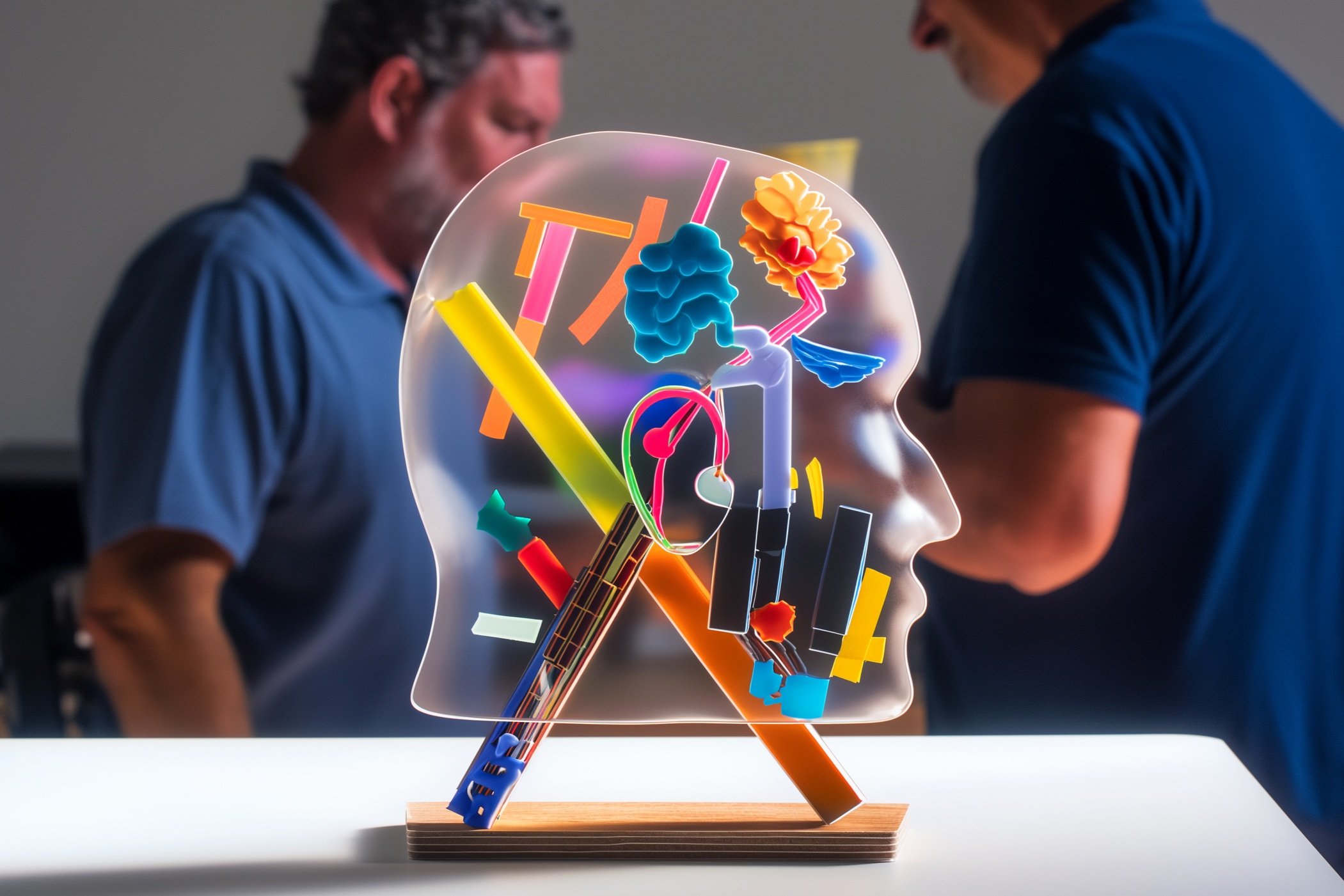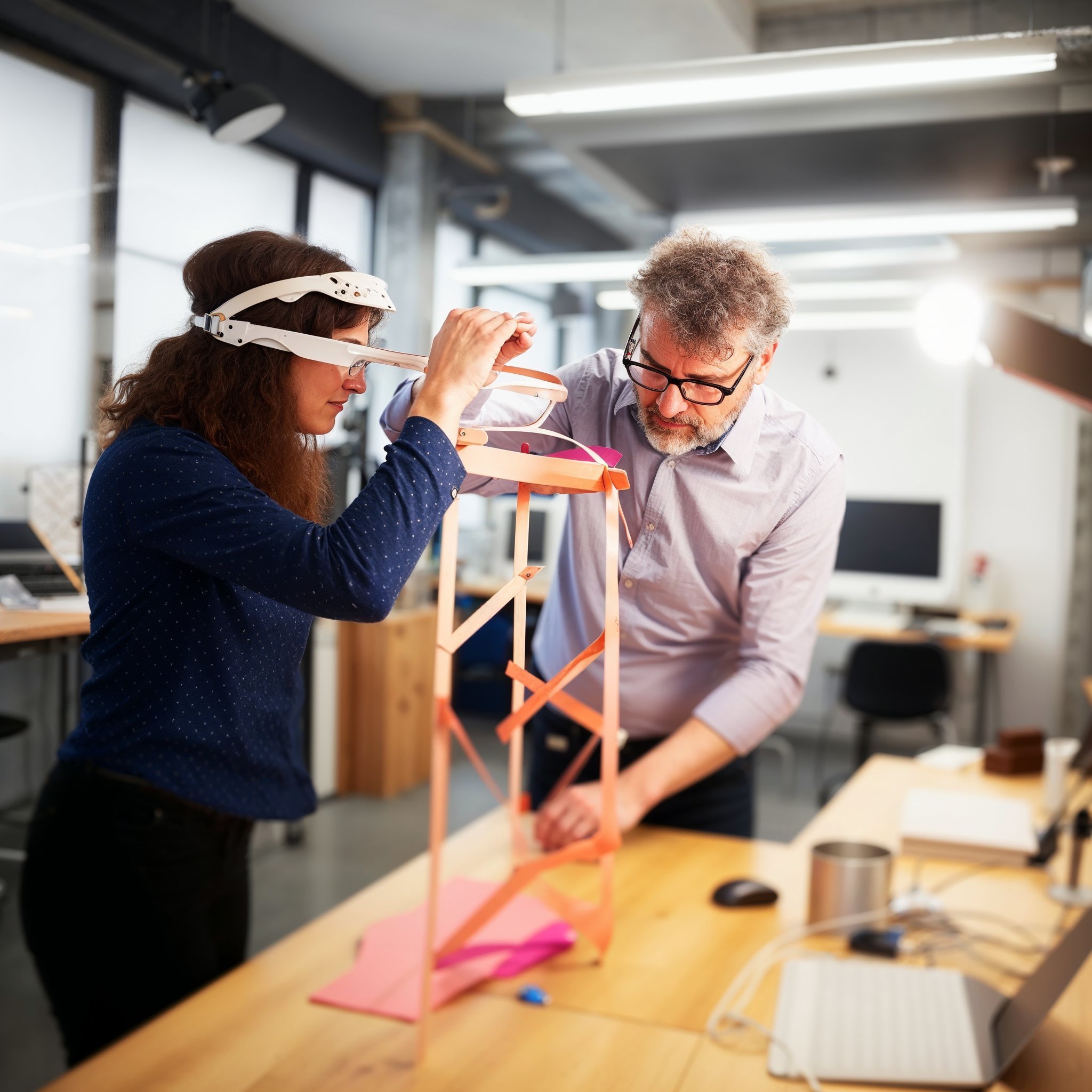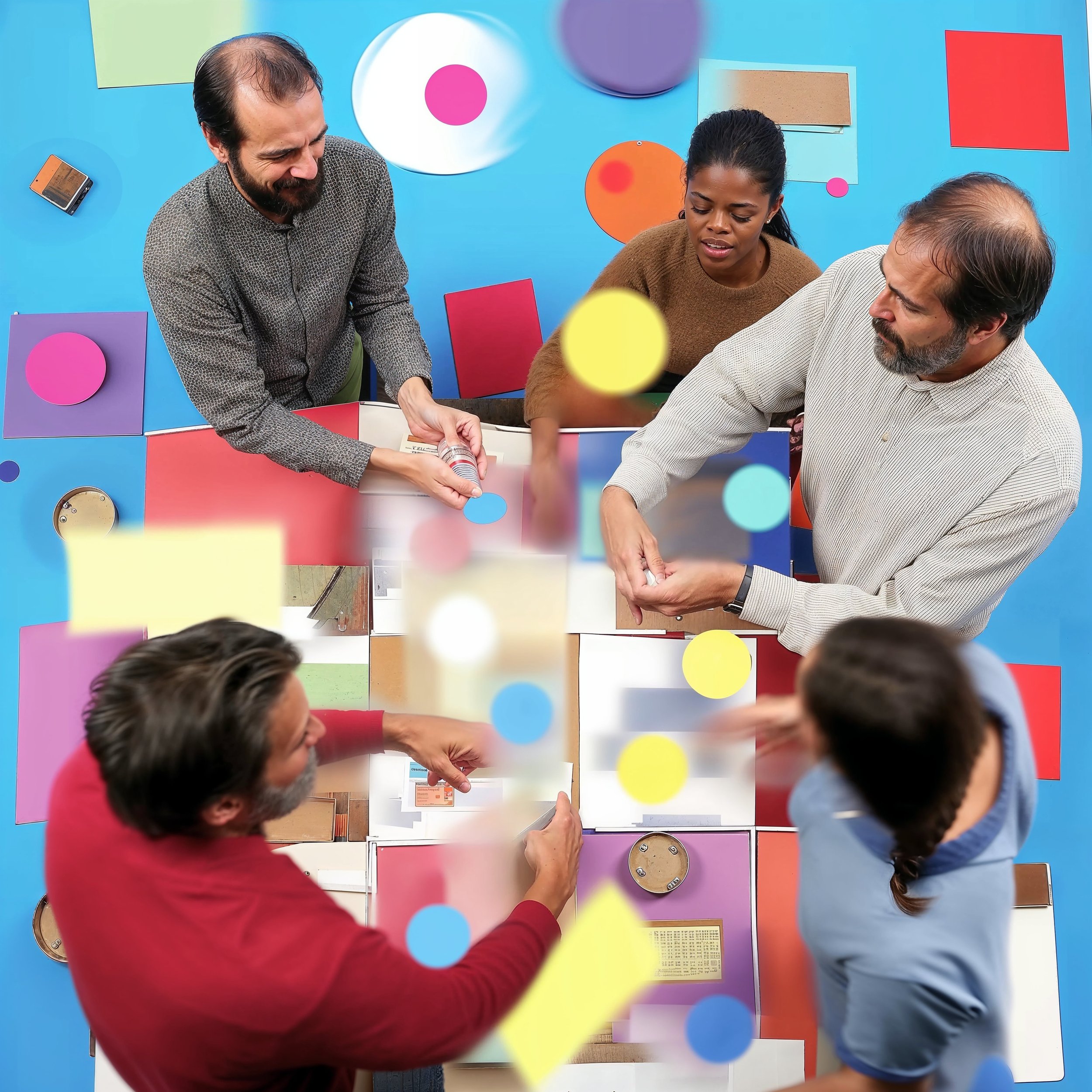Designing Organizational Futures
A Program for Strategic Innovation and Creative Solutions
Partnering Organizations:
During my time at NuVu, I led the development of "Designing Organizational Futures," a five-part program initially conceived in collaboration with Plexus, Peak Scientific, and further extended to Balfour Beatty and Rolls Royce. This initiative was more than a mere workshop; it was an experiential learning journey designed to invigorate creativity and foster innovative problem-solving within the business context.
Our program focused on translating complex challenges faced by organizations into clear, actionable problem statements, thereby enhancing problem-solving capabilities. We emphasized collaboration and co-creation, engaging participants from various backgrounds in sharing and building upon ideas. This process not only yielded innovative solutions but also cultivated deeper mutual respect and understanding, contributing to a more harmonious and productive organizational culture.
One of the key goals was to reduce risks associated with entrenched assumptions by encouraging open discussions on feasible solutions. This approach proved cost-effective, streamlining the development and feedback processes, and delivering outputs more efficiently. The team-building aspect of the program also played a crucial role, providing an unbiased platform for team members to collaboratively work towards common organizational goals.
In essence, "Designing Organizational Futures" served the true business needs by fostering outcomes rooted in creative thinking and analytical decision-making. It provided actionable strategies and a robust framework for problem-solving, resonating with users and delivering a high business impact. The program embodied a blend of theoretical understanding and practical application, geared towards equipping participants with a comprehensive grasp of each innovation stage and how to apply these principles in real-world scenarios.
Impact Reach: 95 Tech and Business Leaders
Longevity lies in adapting and innovating. In a constantly evolving world, staying ahead means embracing change and reimagining what’s possible.
Program Objectives
Advanced Design Thinking Application
Deepen understanding and application of Design Thinking as a core framework for innovation within diverse organizations, leveraging it for complex problem-solving and strategic development.
Enhance Critical and Conceptual Thinking
Build proficiency in conceptual thinking, enhancing participants' ability to brainstorm effectively and offer constructive critiques. This nurtures a more dynamic and adaptable innovation process within teams.
Hands-On Ideation for Real-World Challenges
Focus on practical, hands-on ideation, empowering participants to apply their skills directly to tangible problems their organizations face, fostering a solution-oriented mindset.
Cultivate a Feedback-Driven Culture
Foster a culture that actively seeks and utilizes feedback for continuous improvement, enhancing project outcomes and encouraging a growth mindset within the organization.
Strengthen Team Dynamics and Collaboration
Offer experiences that enrich team-building and collaboration, fostering unity and cross-functional teamwork, essential for a cohesive and innovative organizational culture.
Leverage Diversity for Enhanced Innovation
Develop the ability to utilize diverse perspectives for more comprehensive problem-solving by fostering and embracing varied viewpoints.
Part 1: Conceptual Thinking
Navigating Complexity through Insight
In the first phase of "Designing Organizational Futures," participants delved into the vital skill of Conceptual Thinking, crucial for innovating effectively. This segment went beyond mere problem comprehension, diving into exploring root causes and broader implications. Attendees participated in various exercises aimed at expanding their viewpoints on challenges. These activities involved making connections among diverse elements, uncovering underlying patterns, and generating creative solutions. As a result, participants developed an enhanced capability to tackle complex issues from innovative and varied perspectives, setting a solid groundwork for the ideation stages that followed.
-
Participants were given a range of objects and scenarios. Their task was to identify and map out the underlying concepts connecting these seemingly unrelated items, fostering an ability to see beyond the surface and find deeper links and patterns.
-
In this exercise, participants were presented with a series of abstract concepts. They had a limited time (first one minute, then 30 seconds) to sketch their interpretation of each concept. This activity encouraged quick, fearless thinking and the ability to visually express abstract ideas under time pressure.
-
Towards the end of the module, participants were asked to reflect on how employing conceptual thinking could shed new light on existing challenges in their work. This exercise aimed to connect the skill of conceptual thinking directly to their real-world professional scenarios, encouraging them to think beyond immediate details and foster innovative solutions.
Part 2: Team Brainstorming
The Dynamics of Collective Creativity
In the second stage of "Designing Organizational Futures," participants explored the nuanced art and science of brainstorming. This phase was centered not just on the generation of ideas, but on identifying the most promising ones among many. We integrated both traditional and contemporary brainstorming techniques in a group setting, emphasizing inclusivity and collaboration. The activities were tailored to encourage every participant's active involvement, fostering a culture of teamwork. One key component was the use of "How Might We" (HMW) questions, which helped to frame the brainstorming session with open-ended, solution-oriented queries. For instance, in addressing a common issue like insufficient daily water intake, a HMW question posed was, "How might we make hydration a fun and engaging part of people's daily routine?" This approach prompted creative thinking and a broad range of potential solutions. Furthermore, participants engaged in a group brainstorming activity, using the HMW questions as a basis to generate numerous ideas. The rules were clear: no criticism, wild ideas encouraged, focus on quantity, and build upon each other's suggestions. To tie this back to their professional work, an activity was introduced where participants applied these brainstorming techniques to real challenges faced in their respective organizations. This practical application ensured that the skills learned were directly relevant and immediately applicable to their professional environments.
-
This is a fast-paced, iterative brainstorming exercise where participants rapidly build upon each other's ideas. In small groups, one person starts by suggesting an idea, and the next person quickly adds or modifies it, passing it on like a relay race. This exercise emphasizes speed and spontaneity, encouraging participants to think quickly and creatively without overanalyzing. It's designed to generate a wide array of ideas in a short time and showcases the power of collaborative, additive thinking.
-
Participants were guided to create HMW questions relevant to their organizational challenges. This involved framing open-ended, solution-oriented queries, and fostering creativity and broad thinking. For example, if a challenge for increasing daily water intake, an HMW question might be “How might we make hydration an enjoyable daily habit?”
-
Using the HMW questions, participants engaged in a brainstorming session within their groups. The focus was on generating a high volume of ideas, encouraging wild and creative thinking, and building upon each other's suggestions without criticism.
Part 3: Feedback & Critique
Catalyst for Continuous Improvement
In this critical segment of "Designing Organizational Futures," we honed in on the art and science of feedback and critique, an often overlooked yet vital aspect of the innovation cycle. This module emphasized enhancing participants' skills in offering and receiving both critical and constructive feedback. Through a series of structured exercises, attendees learned how to provide feedback that was specific, objective, and actionable, aligning with the best practices and goals of their projects. The exercises were designed to cultivate a culture of continuous improvement, fostering an environment where regular, constructive exchanges of ideas and critiques are the norm, thus elevating the quality and effectiveness of projects and initiatives.
-
In a chain format, one participant starts by critiquing an aspect of a project. The next participant builds upon this critique with an additional point, and so on. This activity emphasizes the collective development of a comprehensive critique, encouraging participants to build upon each other's insights and foster a collaborative approach to improvement.
-
Participants work in pairs to identify potential blindspots in each other's projects or approaches, followed by a group discussion on how to address these blindspots. This activity aims to enhance self-awareness and the ability to perceive and constructively critique aspects of a project that may be overlooked.
-
Attendees bring a real project or decision from their work and receive structured critique from the group. This exercise applies the principles of effective critique to actual professional scenarios, allowing participants to see the practical impact of constructive feedback.
Diversity & Inclusion Drive Innovation
We delve into the power of multifaceted thinking, augmented by Diversity and Inclusion principles to broaden your problem-solving abilities by embracing a spectrum of perspectives. Through structured exercises, you'll learn to shift your mindset between logical analysis, emotional insight, and creative thinking. You'll witness first-hand how embracing varied perspectives amplifies the effectiveness of your problem-solving approaches. By the conclusion of this part, you'll have an enriched understanding of how the fusion of diverse viewpoints offers more innovative and well-rounded solutions." I need you to rewrite this and then come up with 3 activities
Part 4: Multifaceted Thinking
-
Participants take part in exercises that require them to adopt different viewpoints, such as those of various stakeholders or user groups. This activity helps in understanding how considering different perspectives can lead to more well-rounded and inclusive solutions.
-
Through role-playing scenarios, participants explore the emotional dimensions of decision-making and problem-solving. This exercise emphasizes the value of emotional intelligence and empathy in understanding and addressing diverse needs and challenges.
-
Small groups are tasked with designing a solution to a common problem, ensuring it's inclusive and takes into account different perspectives and needs. This activity emphasizes the practical application of inclusive thinking in solution design, underscoring the importance of diverse inputs in creating effective solutions.
Part 5: Project
Ideation in Action
In the final segment of "Designing Organizational Futures," participants engaged in a dynamic, hands-on project that encapsulated all the learnings from the program. This stage was a deep dive into practical application, where teams actively applied their newfound skills and insights to address real-world challenges. Utilizing our specially designed Studio Cards as a framework, each group embarked on an iterative design process, evolving their ideas from initial concepts to workable prototypes. This culminated in a vibrant showcase of how theory transforms into tangible solutions, with each team navigating through ideation rounds to craft innovative solutions for actual organizational problems.
-
Teams choose a real-world problem, then brainstorm and map out multiple solutions. This activity involves considering different aspects such as feasibility, innovation, and impact. The mapping process encourages visual thinking and group collaboration to develop a comprehensive understanding of the problem and potential solutions.
-
Teams create a physical or digital prototype of their solution. The workshop focuses on rapid prototyping techniques, allowing teams to visualize their ideas and receive immediate feedback. This process is iterative, with teams refining their prototypes based on insights gathered during the development phase.
-
Teams display their prototypes in a fair-like setting, inviting feedback and discussion from other participants. This interactive session is followed by a roundtable where each team presents an impact analysis of their solution, considering its practicality, scalability, and potential effect. This combination of showcasing and analytical discussion provides a holistic view of each solution's viability and potential impact.
Outcomes
Success
The program effectively instilled a culture of innovation and collaboration. Participants significantly enhanced their understanding of Design Thinking, applying it to complex organizational challenges. They developed robust problem-solving skills and innovative thinking. The exercises fostered teamwork, enabling participants to work collaboratively, share diverse ideas, and build upon them. This collective approach led to more comprehensive and creative solutions, aligning with modern organizational needs. The program's hands-on nature ensured that participants gained practical skills alongside theoretical knowledge, making them well-equipped to drive innovation in their respective organizations.
Limitations
The primary challenge was the practical integration of the program's concepts into real-world business settings. While participants excelled in conceptual thinking and collaborative ideation, applying these skills within the constraints of their existing organizational structures and cultures proved difficult for some. There was a gap between the innovative ideas generated during the program and their implementation in a typical business environment. This issue highlighted the need for additional support and guidance in bridging the gap between theory and practice, ensuring that the creative solutions and strategies developed during the program could be effectively and sustainably integrated into everyday business operations.









